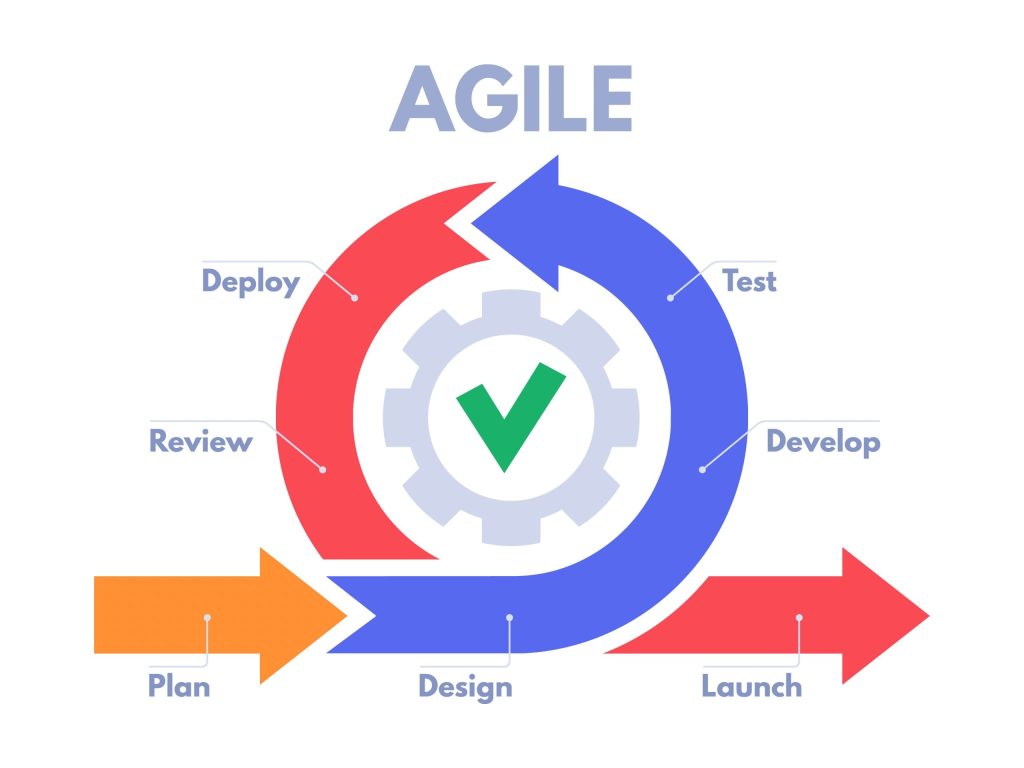
Overview of Agile Methodology
Agile Methodology is a dynamic approach to project management that focuses on flexibility, collaboration, and customer satisfaction. Unlike traditional models, Agile is iterative. This allows teams to adapt to changing requirements and deliver incremental progress throughout the project lifecycle. This method emphasizes continuous feedback, which ensures that the final product aligns closely with stakeholder expectations. The core principles of Agile include regular communication, frequent delivery of functional software, and valuing individuals over processes.
One of the fundamental differences between Agile and traditional methodologies like Waterfall is their approach to planning and execution. In Waterfall, projects follow a linear, sequential path, where each phase must be completed before moving to the next. This model works well for projects with clear, unchanging requirements. However, in rapidly evolving industries, Waterfall can lead to delays. This is because changes are difficult to accommodate once a phase is completed. Agile, by contrast, embraces change and encourages frequent reassessments and adjustments throughout the project. This flexibility enables teams to respond quickly to shifting priorities or unforeseen challenges.
The iterative nature of Agile also leads to faster delivery. Rather than waiting until the end of the project to deliver a complete product, Agile teams work in short sprints. They do this by delivering small but functional parts of the project along the way. This approach reduces risk and ensures that value is being delivered consistently. By maintaining close collaboration with stakeholders, Agile teams can refine the project’s direction as needed. This results in a higher quality end product. Consequently, Agile Methodology has become the preferred choice for businesses looking to innovate and remain competitive in fast-paced markets.
Key Agile Frameworks
Agile Methodology
Agile Methodology encompasses various frameworks that provide structure to teams adopting an Agile approach. The most widely used frameworks include Scrum, Kanban, and Lean, each suited for different types of projects and organizational needs. While all of these frameworks align with Agile principles, they differ in their specific processes and practices. They offer businesses the flexibility to choose the framework that best fits their project requirements and workflows.
Scrum
Scrum is one of the most popular Agile frameworks, especially for software development. It organizes work into time-boxed sprints that typically lasting two to four weeks. The goal is to deliver a functional product increment at the end of each sprint. Scrum teams rely on daily stand-up meetings and roles like Scrum Master and Product Owner to maintain focus and accountability. This framework is ideal for businesses that need to deliver complex products in stages while ensuring constant collaboration and adaptability. Scrum works best in dynamic environments where requirements change frequently, and teams need to stay aligned with evolving business priorities.
Kanban
Kanban, on the other hand, offers a more visual approach to managing work. Using a Kanban board tracks tasks as they move through stages of completion. Unlike Scrum, Kanban does not use sprints or predefined time periods for work. Instead, teams focus on continuous delivery, pulling tasks from a backlog as capacity allows. This framework is particularly effective for teams working on projects with a steady flow of tasks, such as support or maintenance work, where priorities shift frequently. Kanban’s emphasis on workflow efficiency and reducing bottlenecks makes it a powerful tool for improving operational processes.
Lean Principles
Lean, rooted in manufacturing principles, focuses on minimizing waste and maximizing value. In the context of Agile Methodology, Lean encourages teams to streamline processes and eliminate non-essential activities that do not add value to the customer. Businesses that adopt Lean often look for ways to optimize their operations and enhance overall efficiency. This framework is especially useful in industries that demand high productivity and cost-effectiveness, making it a strong fit for manufacturing, healthcare, and service-oriented sectors.
By selecting the appropriate Agile framework, businesses can tailor their processes to meet their unique challenges, ensuring they remain competitive and efficient in today’s fast-moving markets.
Benefits of Agile for Businesses
Agile Methodology offers significant benefits to businesses by improving adaptability, enhancing customer satisfaction, and increasing project efficiency. One of the core strengths of Agile is its ability to adapt quickly to changing market demands or project requirements. Traditional project management models often struggle to accommodate changes once a project is underway, but Agile thrives on flexibility. By breaking projects into short, iterative cycles, teams can pivot and adjust their work to align with shifting priorities, allowing businesses to respond more effectively to evolving market trends.
Customer satisfaction is another key advantage of Agile. Since Agile Methodology emphasizes continuous collaboration with stakeholders, customers are involved throughout the development process. Regular feedback loops ensure that customer needs are addressed at every stage, which leads to a higher quality product that better aligns with expectations. This close engagement allows businesses to not only meet customer demands more accurately but also to build stronger relationships with their clients by demonstrating responsiveness and transparency.
Agile also drives project efficiency by focusing on delivering functional product increments quickly and consistently. Teams working within an Agile framework are able to identify potential issues early and make necessary adjustments, preventing costly delays or rework. Agile’s emphasis on continuous improvement means that each iteration builds on the success of the previous one, leading to steady progress and a more streamlined workflow. As a result, businesses that adopt Agile Methodology often see faster project completion times and a higher return on investment, making it a powerful tool for driving innovation and business success.
By embracing Agile, businesses not only improve their operational efficiency but also foster a culture of collaboration and innovation, positioning themselves for long-term success in competitive industries.
Common Challenges and Solutions in Agile Adoption
Adopting Agile Methodology offers numerous benefits, but businesses often encounter challenges during implementation. One of the most common obstacles is cultural resistance within the organization. Agile demands a shift from traditional, hierarchical management structures to a more collaborative, team-based approach. Employees and managers accustomed to rigid processes may find it difficult to embrace Agile’s flexibility. To overcome this, businesses should invest in comprehensive training and encourage open communication. Leadership support is also crucial; when leaders actively advocate for Agile practices, it creates a culture that supports change and continuous improvement.
Another challenge businesses face in Agile adoption is the misalignment of Agile principles with existing processes. Many organizations attempt to blend Agile with traditional project management methods, which can lead to confusion and inefficiencies. For instance, trying to fit Agile into a waterfall-style planning structure can negate Agile’s benefits of flexibility and quick feedback loops. The solution to this issue lies in fully committing to Agile principles and frameworks. Businesses need to reassess their current processes and restructure them to align with Agile’s iterative and incremental approach. Teams should also be empowered to make decisions and take ownership of their work, as this fosters the autonomy that Agile relies on.
Collaboration and Transparency
In addition, businesses often struggle with maintaining effective communication across teams, especially in larger organizations or remote setups. Agile Methodology requires constant collaboration and transparency to ensure smooth progress. To address this, businesses can implement tools such as project management software that support Agile frameworks like Scrum and Kanban. Regular check-ins, such as daily stand-up meetings, also help keep team members aligned and address any issues promptly. By ensuring teams have the right tools and communication practices in place, businesses can reduce silos and ensure a more seamless Agile adoption process.
Through proper training, alignment of processes, and enhanced communication, businesses can overcome these common challenges and fully realize the benefits that Agile Methodology offers.
The Role of Agile in Driving Continuous Improvement
Agile Methodology plays a critical role in driving continuous improvement by fostering a culture centered around iteration and feedback. At its core, Agile encourages teams to reflect on their processes and outcomes regularly, enabling them to identify areas for improvement. By working in short, iterative cycles called sprints, Agile teams can make frequent adjustments based on real-time feedback from both customers and stakeholders. This constant evaluation allows businesses to refine their strategies, leading to enhanced efficiency and product quality over time.
One of the key practices that support continuous improvement in Agile is the retrospective meeting. At the end of each sprint, teams come together to discuss what went well, what challenges they faced, and how they can improve in the next iteration. These discussions promote transparency and accountability, empowering teams to take ownership of both their successes and areas for development. As a result, teams can continuously optimize their workflow and processes, contributing to long-term business growth. This iterative approach not only improves operational efficiency but also builds resilience, enabling businesses to adapt quickly to changing market conditions.
Moreover, Agile Methodology places a strong emphasis on feedback from end-users. By engaging customers throughout the development process, businesses can gain valuable insights into user needs and preferences. This feedback loop helps ensure that the product evolves in line with customer expectations, leading to higher satisfaction and greater market relevance. Over time, this approach allows businesses to develop products that are more competitive, innovative, and aligned with real-world demands.
By fostering a mindset of continuous improvement, Agile empowers businesses to stay ahead of the curve in a fast-paced, competitive landscape. Through regular iteration and feedback, companies can not only improve their processes but also drive innovation and sustained business success.
Conclusion
In conclusion, Agile Methodology has revolutionized how businesses manage projects, fostering a more adaptive, customer-focused, and efficient approach. Its emphasis on flexibility and collaboration enables companies to respond quickly to changing market demands while maintaining a high standard of quality. By incorporating iterative cycles and regular feedback, Agile not only drives continuous improvement but also ensures that projects align with customer needs. This method cultivates innovation and encourages teams to be more proactive, which is essential for staying competitive in today’s fast-paced business environment.
Although adopting Agile comes with challenges, the benefits far outweigh the hurdles. Businesses that commit to Agile’s principles see greater efficiency, improved customer satisfaction, and more successful project outcomes. The methodology’s ability to drive ongoing progress helps businesses not only complete projects faster but also stay ahead of the competition. Moreover, as organizations continue to embrace digital transformation, Agile Methodology proves to be a crucial tool for maintaining relevance and fostering long-term growth.
By embracing Agile fully, businesses can unlock new levels of operational excellence and create products and services that resonate with customers. Ultimately, Agile empowers organizations to be more innovative, resilient, and successful in a rapidly evolving market landscape.


